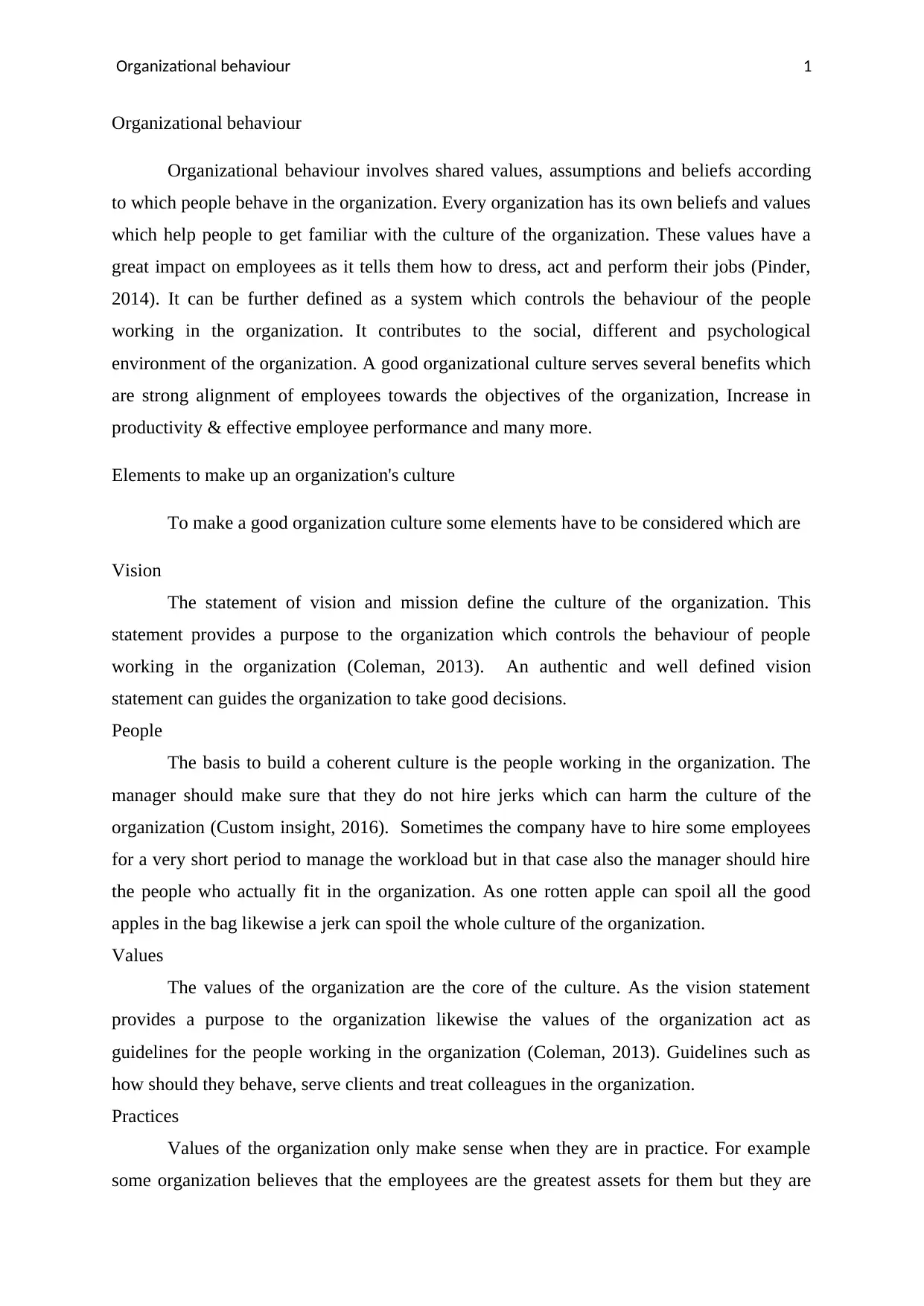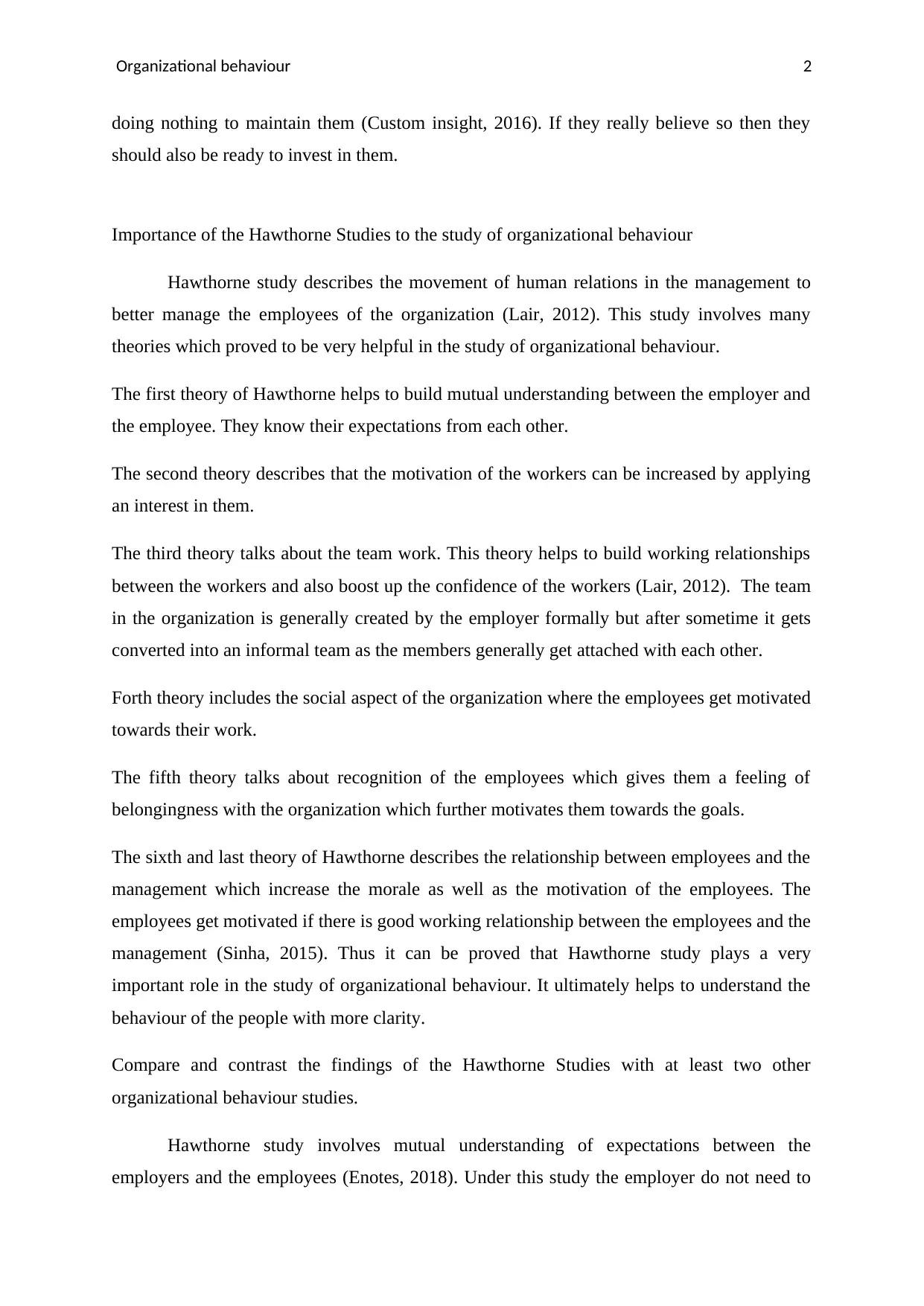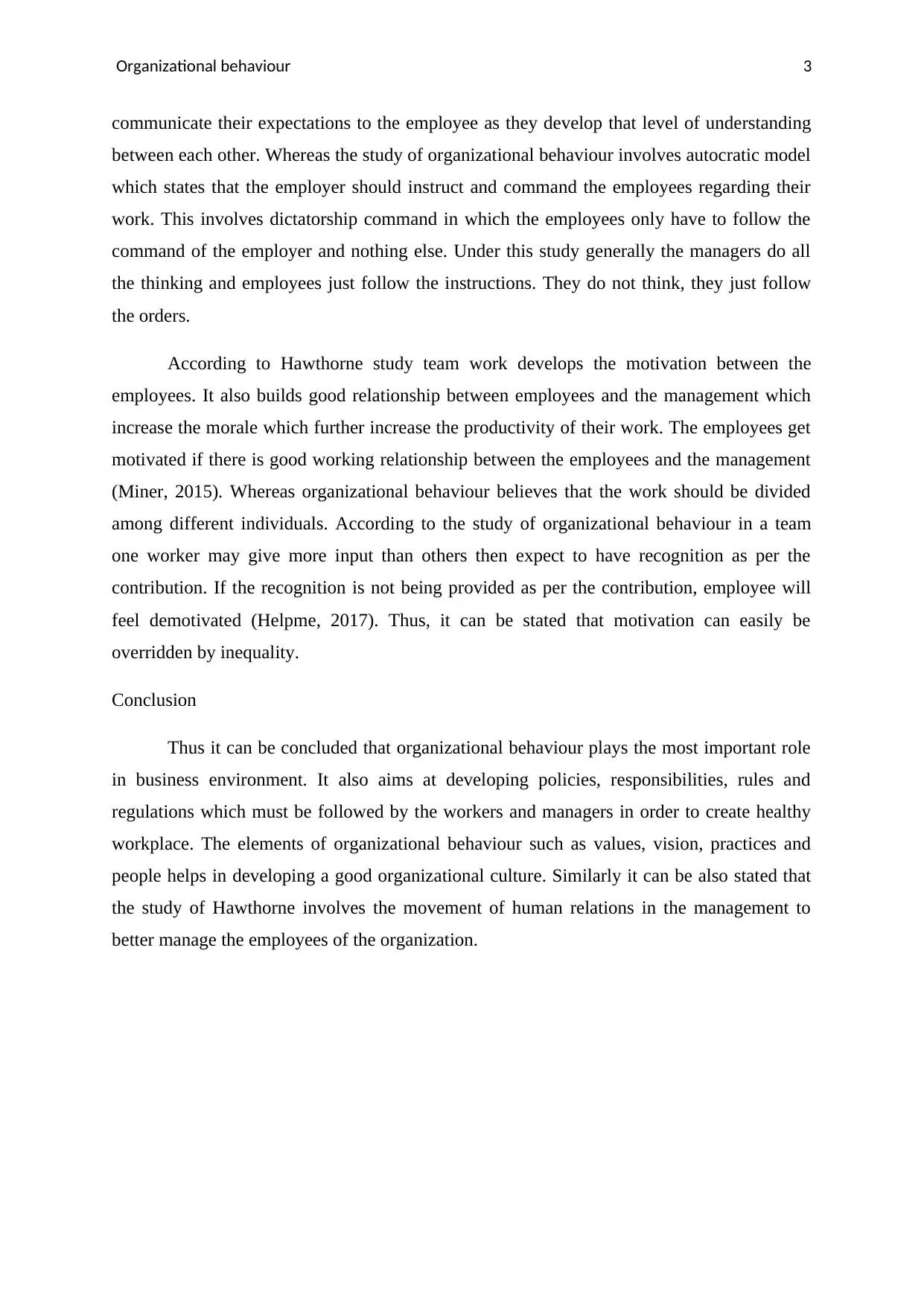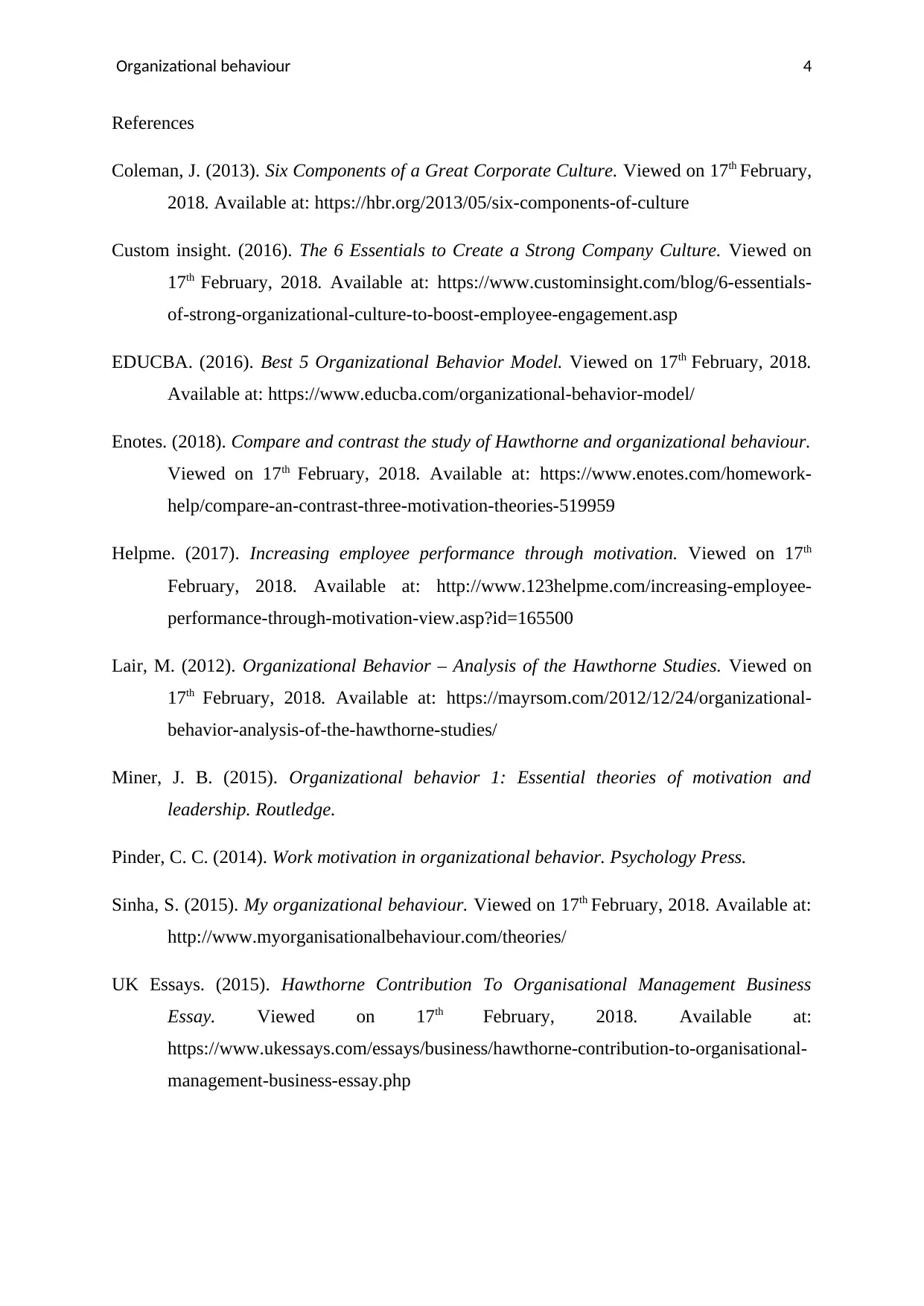Exploring the Dynamics of Organizational Culture and Behaviour
VerifiedAdded on 2020/05/16
|5
|1368
|51
AI Summary
Organizational behaviour is a multifaceted field encompassing the study of shared values, assumptions, beliefs, and systems influencing how individuals behave within an organization. A robust organizational culture is crucial for aligning employees with company objectives and enhancing productivity. Key elements include a clear vision providing direction, people who embody the culture, core values guiding decision-making, and practices reflecting these values. The Hawthorne Studies significantly contributed to this field by emphasizing the importance of human relations and motivation in management. This essay compares organizational behaviour models, discusses motivation theories, and evaluates how recognition affects employee performance. Understanding these dynamics is essential for fostering a healthy workplace environment conducive to success.

Organizational behaviour
Student details
Email id
Student details
Email id
Paraphrase This Document
Need a fresh take? Get an instant paraphrase of this document with our AI Paraphraser

Organizational behaviour 1
Organizational behaviour
Organizational behaviour involves shared values, assumptions and beliefs according
to which people behave in the organization. Every organization has its own beliefs and values
which help people to get familiar with the culture of the organization. These values have a
great impact on employees as it tells them how to dress, act and perform their jobs (Pinder,
2014). It can be further defined as a system which controls the behaviour of the people
working in the organization. It contributes to the social, different and psychological
environment of the organization. A good organizational culture serves several benefits which
are strong alignment of employees towards the objectives of the organization, Increase in
productivity & effective employee performance and many more.
Elements to make up an organization's culture
To make a good organization culture some elements have to be considered which are
Vision
The statement of vision and mission define the culture of the organization. This
statement provides a purpose to the organization which controls the behaviour of people
working in the organization (Coleman, 2013). An authentic and well defined vision
statement can guides the organization to take good decisions.
People
The basis to build a coherent culture is the people working in the organization. The
manager should make sure that they do not hire jerks which can harm the culture of the
organization (Custom insight, 2016). Sometimes the company have to hire some employees
for a very short period to manage the workload but in that case also the manager should hire
the people who actually fit in the organization. As one rotten apple can spoil all the good
apples in the bag likewise a jerk can spoil the whole culture of the organization.
Values
The values of the organization are the core of the culture. As the vision statement
provides a purpose to the organization likewise the values of the organization act as
guidelines for the people working in the organization (Coleman, 2013). Guidelines such as
how should they behave, serve clients and treat colleagues in the organization.
Practices
Values of the organization only make sense when they are in practice. For example
some organization believes that the employees are the greatest assets for them but they are
Organizational behaviour
Organizational behaviour involves shared values, assumptions and beliefs according
to which people behave in the organization. Every organization has its own beliefs and values
which help people to get familiar with the culture of the organization. These values have a
great impact on employees as it tells them how to dress, act and perform their jobs (Pinder,
2014). It can be further defined as a system which controls the behaviour of the people
working in the organization. It contributes to the social, different and psychological
environment of the organization. A good organizational culture serves several benefits which
are strong alignment of employees towards the objectives of the organization, Increase in
productivity & effective employee performance and many more.
Elements to make up an organization's culture
To make a good organization culture some elements have to be considered which are
Vision
The statement of vision and mission define the culture of the organization. This
statement provides a purpose to the organization which controls the behaviour of people
working in the organization (Coleman, 2013). An authentic and well defined vision
statement can guides the organization to take good decisions.
People
The basis to build a coherent culture is the people working in the organization. The
manager should make sure that they do not hire jerks which can harm the culture of the
organization (Custom insight, 2016). Sometimes the company have to hire some employees
for a very short period to manage the workload but in that case also the manager should hire
the people who actually fit in the organization. As one rotten apple can spoil all the good
apples in the bag likewise a jerk can spoil the whole culture of the organization.
Values
The values of the organization are the core of the culture. As the vision statement
provides a purpose to the organization likewise the values of the organization act as
guidelines for the people working in the organization (Coleman, 2013). Guidelines such as
how should they behave, serve clients and treat colleagues in the organization.
Practices
Values of the organization only make sense when they are in practice. For example
some organization believes that the employees are the greatest assets for them but they are

Organizational behaviour 2
doing nothing to maintain them (Custom insight, 2016). If they really believe so then they
should also be ready to invest in them.
Importance of the Hawthorne Studies to the study of organizational behaviour
Hawthorne study describes the movement of human relations in the management to
better manage the employees of the organization (Lair, 2012). This study involves many
theories which proved to be very helpful in the study of organizational behaviour.
The first theory of Hawthorne helps to build mutual understanding between the employer and
the employee. They know their expectations from each other.
The second theory describes that the motivation of the workers can be increased by applying
an interest in them.
The third theory talks about the team work. This theory helps to build working relationships
between the workers and also boost up the confidence of the workers (Lair, 2012). The team
in the organization is generally created by the employer formally but after sometime it gets
converted into an informal team as the members generally get attached with each other.
Forth theory includes the social aspect of the organization where the employees get motivated
towards their work.
The fifth theory talks about recognition of the employees which gives them a feeling of
belongingness with the organization which further motivates them towards the goals.
The sixth and last theory of Hawthorne describes the relationship between employees and the
management which increase the morale as well as the motivation of the employees. The
employees get motivated if there is good working relationship between the employees and the
management (Sinha, 2015). Thus it can be proved that Hawthorne study plays a very
important role in the study of organizational behaviour. It ultimately helps to understand the
behaviour of the people with more clarity.
Compare and contrast the findings of the Hawthorne Studies with at least two other
organizational behaviour studies.
Hawthorne study involves mutual understanding of expectations between the
employers and the employees (Enotes, 2018). Under this study the employer do not need to
doing nothing to maintain them (Custom insight, 2016). If they really believe so then they
should also be ready to invest in them.
Importance of the Hawthorne Studies to the study of organizational behaviour
Hawthorne study describes the movement of human relations in the management to
better manage the employees of the organization (Lair, 2012). This study involves many
theories which proved to be very helpful in the study of organizational behaviour.
The first theory of Hawthorne helps to build mutual understanding between the employer and
the employee. They know their expectations from each other.
The second theory describes that the motivation of the workers can be increased by applying
an interest in them.
The third theory talks about the team work. This theory helps to build working relationships
between the workers and also boost up the confidence of the workers (Lair, 2012). The team
in the organization is generally created by the employer formally but after sometime it gets
converted into an informal team as the members generally get attached with each other.
Forth theory includes the social aspect of the organization where the employees get motivated
towards their work.
The fifth theory talks about recognition of the employees which gives them a feeling of
belongingness with the organization which further motivates them towards the goals.
The sixth and last theory of Hawthorne describes the relationship between employees and the
management which increase the morale as well as the motivation of the employees. The
employees get motivated if there is good working relationship between the employees and the
management (Sinha, 2015). Thus it can be proved that Hawthorne study plays a very
important role in the study of organizational behaviour. It ultimately helps to understand the
behaviour of the people with more clarity.
Compare and contrast the findings of the Hawthorne Studies with at least two other
organizational behaviour studies.
Hawthorne study involves mutual understanding of expectations between the
employers and the employees (Enotes, 2018). Under this study the employer do not need to
⊘ This is a preview!⊘
Do you want full access?
Subscribe today to unlock all pages.

Trusted by 1+ million students worldwide

Organizational behaviour 3
communicate their expectations to the employee as they develop that level of understanding
between each other. Whereas the study of organizational behaviour involves autocratic model
which states that the employer should instruct and command the employees regarding their
work. This involves dictatorship command in which the employees only have to follow the
command of the employer and nothing else. Under this study generally the managers do all
the thinking and employees just follow the instructions. They do not think, they just follow
the orders.
According to Hawthorne study team work develops the motivation between the
employees. It also builds good relationship between employees and the management which
increase the morale which further increase the productivity of their work. The employees get
motivated if there is good working relationship between the employees and the management
(Miner, 2015). Whereas organizational behaviour believes that the work should be divided
among different individuals. According to the study of organizational behaviour in a team
one worker may give more input than others then expect to have recognition as per the
contribution. If the recognition is not being provided as per the contribution, employee will
feel demotivated (Helpme, 2017). Thus, it can be stated that motivation can easily be
overridden by inequality.
Conclusion
Thus it can be concluded that organizational behaviour plays the most important role
in business environment. It also aims at developing policies, responsibilities, rules and
regulations which must be followed by the workers and managers in order to create healthy
workplace. The elements of organizational behaviour such as values, vision, practices and
people helps in developing a good organizational culture. Similarly it can be also stated that
the study of Hawthorne involves the movement of human relations in the management to
better manage the employees of the organization.
communicate their expectations to the employee as they develop that level of understanding
between each other. Whereas the study of organizational behaviour involves autocratic model
which states that the employer should instruct and command the employees regarding their
work. This involves dictatorship command in which the employees only have to follow the
command of the employer and nothing else. Under this study generally the managers do all
the thinking and employees just follow the instructions. They do not think, they just follow
the orders.
According to Hawthorne study team work develops the motivation between the
employees. It also builds good relationship between employees and the management which
increase the morale which further increase the productivity of their work. The employees get
motivated if there is good working relationship between the employees and the management
(Miner, 2015). Whereas organizational behaviour believes that the work should be divided
among different individuals. According to the study of organizational behaviour in a team
one worker may give more input than others then expect to have recognition as per the
contribution. If the recognition is not being provided as per the contribution, employee will
feel demotivated (Helpme, 2017). Thus, it can be stated that motivation can easily be
overridden by inequality.
Conclusion
Thus it can be concluded that organizational behaviour plays the most important role
in business environment. It also aims at developing policies, responsibilities, rules and
regulations which must be followed by the workers and managers in order to create healthy
workplace. The elements of organizational behaviour such as values, vision, practices and
people helps in developing a good organizational culture. Similarly it can be also stated that
the study of Hawthorne involves the movement of human relations in the management to
better manage the employees of the organization.
Paraphrase This Document
Need a fresh take? Get an instant paraphrase of this document with our AI Paraphraser

Organizational behaviour 4
References
Coleman, J. (2013). Six Components of a Great Corporate Culture. Viewed on 17th February,
2018. Available at: https://hbr.org/2013/05/six-components-of-culture
Custom insight. (2016). The 6 Essentials to Create a Strong Company Culture. Viewed on
17th February, 2018. Available at: https://www.custominsight.com/blog/6-essentials-
of-strong-organizational-culture-to-boost-employee-engagement.asp
EDUCBA. (2016). Best 5 Organizational Behavior Model. Viewed on 17th February, 2018.
Available at: https://www.educba.com/organizational-behavior-model/
Enotes. (2018). Compare and contrast the study of Hawthorne and organizational behaviour.
Viewed on 17th February, 2018. Available at: https://www.enotes.com/homework-
help/compare-an-contrast-three-motivation-theories-519959
Helpme. (2017). Increasing employee performance through motivation. Viewed on 17th
February, 2018. Available at: http://www.123helpme.com/increasing-employee-
performance-through-motivation-view.asp?id=165500
Lair, M. (2012). Organizational Behavior – Analysis of the Hawthorne Studies. Viewed on
17th February, 2018. Available at: https://mayrsom.com/2012/12/24/organizational-
behavior-analysis-of-the-hawthorne-studies/
Miner, J. B. (2015). Organizational behavior 1: Essential theories of motivation and
leadership. Routledge.
Pinder, C. C. (2014). Work motivation in organizational behavior. Psychology Press.
Sinha, S. (2015). My organizational behaviour. Viewed on 17th February, 2018. Available at:
http://www.myorganisationalbehaviour.com/theories/
UK Essays. (2015). Hawthorne Contribution To Organisational Management Business
Essay. Viewed on 17th February, 2018. Available at:
https://www.ukessays.com/essays/business/hawthorne-contribution-to-organisational-
management-business-essay.php
References
Coleman, J. (2013). Six Components of a Great Corporate Culture. Viewed on 17th February,
2018. Available at: https://hbr.org/2013/05/six-components-of-culture
Custom insight. (2016). The 6 Essentials to Create a Strong Company Culture. Viewed on
17th February, 2018. Available at: https://www.custominsight.com/blog/6-essentials-
of-strong-organizational-culture-to-boost-employee-engagement.asp
EDUCBA. (2016). Best 5 Organizational Behavior Model. Viewed on 17th February, 2018.
Available at: https://www.educba.com/organizational-behavior-model/
Enotes. (2018). Compare and contrast the study of Hawthorne and organizational behaviour.
Viewed on 17th February, 2018. Available at: https://www.enotes.com/homework-
help/compare-an-contrast-three-motivation-theories-519959
Helpme. (2017). Increasing employee performance through motivation. Viewed on 17th
February, 2018. Available at: http://www.123helpme.com/increasing-employee-
performance-through-motivation-view.asp?id=165500
Lair, M. (2012). Organizational Behavior – Analysis of the Hawthorne Studies. Viewed on
17th February, 2018. Available at: https://mayrsom.com/2012/12/24/organizational-
behavior-analysis-of-the-hawthorne-studies/
Miner, J. B. (2015). Organizational behavior 1: Essential theories of motivation and
leadership. Routledge.
Pinder, C. C. (2014). Work motivation in organizational behavior. Psychology Press.
Sinha, S. (2015). My organizational behaviour. Viewed on 17th February, 2018. Available at:
http://www.myorganisationalbehaviour.com/theories/
UK Essays. (2015). Hawthorne Contribution To Organisational Management Business
Essay. Viewed on 17th February, 2018. Available at:
https://www.ukessays.com/essays/business/hawthorne-contribution-to-organisational-
management-business-essay.php
1 out of 5
Related Documents
Your All-in-One AI-Powered Toolkit for Academic Success.
+13062052269
info@desklib.com
Available 24*7 on WhatsApp / Email
![[object Object]](/_next/static/media/star-bottom.7253800d.svg)
Unlock your academic potential
Copyright © 2020–2025 A2Z Services. All Rights Reserved. Developed and managed by ZUCOL.




